It's All in the Shape
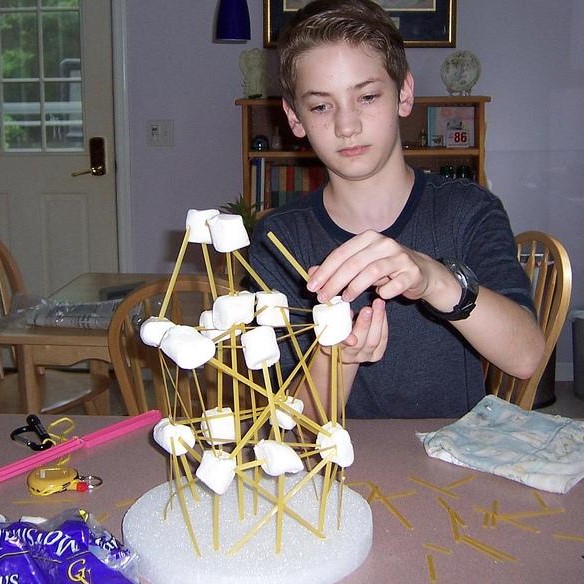
Student making structure with pasta and marshmallows (Jason Kasper [CC BY-SA], Wikimedia Commons)

Student making structure with pasta and marshmallows (Jason Kasper [CC BY-SA], Wikimedia Commons)
How does this align with my curriculum?
| Grade | Course | Topic |
|---|
Students look for shapes in structures and then build and test different frame structures for strength and stability.
Overview
| Activities | Timing | Student Grouping | Description |
|---|---|---|---|
| Minds-On: Shapes of Structures in the Community | 30-45 minutes | Large group | Students learn about the shapes in structures in the world around them by either going on a walk in the school or community or by looking at images of structures |
| Action: Exploring Shapes | 40 minutes | Small group | Students will explore the strength and stability of simple structures they construct and will conduct a fair test to determine which shape of structure is the strongest |
| Consolidation: Which shape is the strongest? | 10 minutes | Independent | Students will summarise their learning by determining which shape is the strongest |
This lesson can be done over a few days.
Students will:
- Explore familiar structures
- Use vocabulary associated with structures
- Explore the strength and stability of self-built frame structures
- Perform a controlled experiment
Learning Goals
Students will:
- Explore familiar structures
- Use vocabulary associated with structures
- Explore the strength and stability of self-built frame structures
- Perform a controlled experiment
Students can:
- Identify shapes found in familiar structures
- Define and describe terminology associated with structures and forces on structures (e.g., structure, load, force, compression, tension, strength, stability)
- Describe how strength and stability of structures are influenced by their shape
- Use a scientific experimentation process and associated skills to conduct an investigation of the strength and stability of frame structures
Success Criteria
Students can:
- Identify shapes found in familiar structures
- Define and describe terminology associated with structures and forces on structures (e.g., structure, load, force, compression, tension, strength, stability)
- Describe how strength and stability of structures are influenced by their shape
- Use a scientific experimentation process and associated skills to conduct an investigation of the strength and stability of frame structures
This icon indicates potential assessment opportunities.
Observations
- Observe and record anecdotally students’ use of terminology during large group discussion and structure testing (Minds-on, Action, Consolidation).
- Observe and record anecdotally students' experimental skills and processes while building and testing structures (Action).
- Observe and record anecdotally students’ observations and conclusions about the strength and stability of various structures (Consolidation).
Conversations
- Listen to and record students as they share observations during the investigation of structural shapes (Action)
Products
- Students could submit their completed Shapes in Structures Observation Sheets as well as their Making and Testing Shapes pages.
Evidence of Student Learning
This icon indicates potential assessment opportunities.
Observations
- Observe and record anecdotally students’ use of terminology during large group discussion and structure testing (Minds-on, Action, Consolidation).
- Observe and record anecdotally students' experimental skills and processes while building and testing structures (Action).
- Observe and record anecdotally students’ observations and conclusions about the strength and stability of various structures (Consolidation).
Conversations
- Listen to and record students as they share observations during the investigation of structural shapes (Action)
Products
- Students could submit their completed Shapes in Structures Observation Sheets as well as their Making and Testing Shapes pages.
Students will:
- Explore familiar structures
- Use vocabulary associated with structures
- Explore the strength and stability of self-built frame structures
- Perform a controlled experiment
Learning Goals
Students will:
- Explore familiar structures
- Use vocabulary associated with structures
- Explore the strength and stability of self-built frame structures
- Perform a controlled experiment
Students can:
- Identify shapes found in familiar structures
- Define and describe terminology associated with structures and forces on structures (e.g., structure, load, force, compression, tension, strength, stability)
- Describe how strength and stability of structures are influenced by their shape
- Use a scientific experimentation process and associated skills to conduct an investigation of the strength and stability of frame structures
Success Criteria
Students can:
- Identify shapes found in familiar structures
- Define and describe terminology associated with structures and forces on structures (e.g., structure, load, force, compression, tension, strength, stability)
- Describe how strength and stability of structures are influenced by their shape
- Use a scientific experimentation process and associated skills to conduct an investigation of the strength and stability of frame structures
This icon indicates potential assessment opportunities.
Observations
- Observe and record anecdotally students’ use of terminology during large group discussion and structure testing (Minds-on, Action, Consolidation).
- Observe and record anecdotally students' experimental skills and processes while building and testing structures (Action).
- Observe and record anecdotally students’ observations and conclusions about the strength and stability of various structures (Consolidation).
Conversations
- Listen to and record students as they share observations during the investigation of structural shapes (Action)
Products
- Students could submit their completed Shapes in Structures Observation Sheets as well as their Making and Testing Shapes pages.
Evidence of Student Learning
This icon indicates potential assessment opportunities.
Observations
- Observe and record anecdotally students’ use of terminology during large group discussion and structure testing (Minds-on, Action, Consolidation).
- Observe and record anecdotally students' experimental skills and processes while building and testing structures (Action).
- Observe and record anecdotally students’ observations and conclusions about the strength and stability of various structures (Consolidation).
Conversations
- Listen to and record students as they share observations during the investigation of structural shapes (Action)
Products
- Students could submit their completed Shapes in Structures Observation Sheets as well as their Making and Testing Shapes pages.
Materials and Preparation
| Material/Technology/Setting | Quantity |
|---|---|
**Educators should follow local guidelines when selecting materials for this lesson. |
For small group work |
|
For teacher use |
Materials
| Material/Technology/Setting | Quantity |
|---|---|
**Educators should follow local guidelines when selecting materials for this lesson. |
For small group work |
|
For teacher use |
- Before beginning the lesson, familiarise yourself with both lesson options and proceed with the preferred option.
- Set up materials for small groups.'
- Print out enough Observation Sheet and Making Shapes Task Card reproducibles for each group. You could laminate these sheets in order to make them reusable for future lessons. Students could use a dry or wet erase marker to fill them out.
- You may also want to print and post the Structures Picture Glossary.
Note: the Making Shapes Task Card does not need to be handed out to each group, it could be projected on a screen for students to view while doing the experiment.
Preparation
- Before beginning the lesson, familiarise yourself with both lesson options and proceed with the preferred option.
- Set up materials for small groups.'
- Print out enough Observation Sheet and Making Shapes Task Card reproducibles for each group. You could laminate these sheets in order to make them reusable for future lessons. Students could use a dry or wet erase marker to fill them out.
- You may also want to print and post the Structures Picture Glossary.
Note: the Making Shapes Task Card does not need to be handed out to each group, it could be projected on a screen for students to view while doing the experiment.
- A basic understanding of shapes and structures.
Student Prior Knowledge and Skills
- A basic understanding of shapes and structures.
| Material/Technology/Setting | Quantity |
|---|---|
**Educators should follow local guidelines when selecting materials for this lesson. |
For small group work |
|
For teacher use |
Materials
| Material/Technology/Setting | Quantity |
|---|---|
**Educators should follow local guidelines when selecting materials for this lesson. |
For small group work |
|
For teacher use |
- Before beginning the lesson, familiarise yourself with both lesson options and proceed with the preferred option.
- Set up materials for small groups.'
- Print out enough Observation Sheet and Making Shapes Task Card reproducibles for each group. You could laminate these sheets in order to make them reusable for future lessons. Students could use a dry or wet erase marker to fill them out.
- You may also want to print and post the Structures Picture Glossary.
Note: the Making Shapes Task Card does not need to be handed out to each group, it could be projected on a screen for students to view while doing the experiment.
Preparation
- Before beginning the lesson, familiarise yourself with both lesson options and proceed with the preferred option.
- Set up materials for small groups.'
- Print out enough Observation Sheet and Making Shapes Task Card reproducibles for each group. You could laminate these sheets in order to make them reusable for future lessons. Students could use a dry or wet erase marker to fill them out.
- You may also want to print and post the Structures Picture Glossary.
Note: the Making Shapes Task Card does not need to be handed out to each group, it could be projected on a screen for students to view while doing the experiment.
- A basic understanding of shapes and structures.
Student Prior Knowledge and Skills
- A basic understanding of shapes and structures.
Teaching and Learning Activities
This icon indicates potential assessment opportunities
Minds-On: Shapes of Structures (30-45 mins.)
| Instructions | Teaching Tips |
|---|---|
|
Before beginning the activity, explain to students that they will be observing a wide variety of structures (e.g., umbrellas, bike helmets, shoes, trees, flowers, nests) that are both natural and human-made. As a class, introduce or review the meaning of structure, such as
Note: refer to the Structures Picture Glossary reproducible [Google doc] [Word doc] [PDF] for more definitions that include visual representations. |
LanguageCreate a word wall of terminology you are likely to use during this lesson such as structure, compression, tension, shape, figure, strength, stability, diagonal, pyramid, cylinder, etc. To further scaffold the word wall, provide students with visual definitions, like this Structures Picture Glossary. You could print them off to use them in a pocket chart or tape them to a wall. Also, you could print off sets and hand them out to small groups. |
|
Go through the It’s all in the shape slideshow with students [Google Slides] [pptx] [PDF]. Facilitate a classroom discussion. Ask students to identify the shape(s) before going over the answers and showing them the shape overlays. Encourage students to think about the shapes as part of the structural integrity. 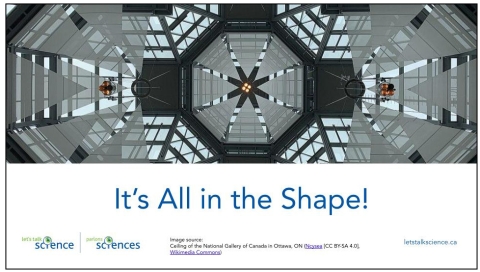
|
IdeaYou could use the slideshow with Pear Deck for an interactive slideshow experience. You could also use Pear Deck as an assessment opportunity. If you are unfamiliar with Pear Deck check out the Pear Deck support page. Note: Pear Deck is free but it does require signing up. |
|
Place students in small groups. Provide each small group with a clipboard, pencil and the Shapes in Structures Observation Sheet reproducible [Google doc] [Word doc] [PDF]. 
Explain to students that they will be going for a walk to look at structures. As part of this they will also look for the shapes they see in the structures. The walk could take place inside the school, out in the school yard or in the local neighbourhood. Note: Alternatively, you could take pictures of structures from around the local community and project on screen for students to look at. |
SafetyReview your school’s guidelines and instructions for participating in outdoor activities. TechnologyIf your class has access to iPads or tablets, you could use Goosechase which is a fun scavenger activity. For example, you could have students submit a photo of a structure containing specified shape(s) and turn it into a scavenger hunt game. If you are unfamiliar with Goosechase refer to their FAQ page for support on how to run this activity. DiscussionsDiscussion prompts can include:
IdeaVisually impaired students could safely feel structures and describe shapes that they feel. If time is short, students could do this activity individually at home. |
Action: Exploring Shapes (40 mins.)
| Instructions | Teaching Tips |
|---|---|
|
Show students this video which shows how you can change the shape of an object. Note: You may wish to pause the video at 6:23 minutes as the graph may be too challenging for grade 3s to follow. |
Images and VideosFor students who are visually impaired, describe what is being shown on screen. |
|
Place the students in small groups and provide each group with the building materials, fasteners and books to use as weight. Provide each group with the Making and Testing Shapes reproducible [Google doc] [Word doc] [PDF]. 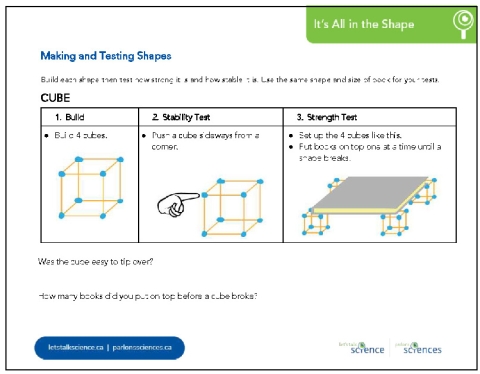
Explain to students that they are to follow the instructions on the four task cards and use the materials provided to make basic shapes and structures (cube, cylinder, cone, triangular pyramid). It is important to remind students to measure and ensure the sticks are the same length, otherwise, they will build shapes of all different sizes, making it difficult to balance the books and it will not be a fair test based on shape. You can see a demonstration on how to these shapes are built in this video or this video They will then use the shapes to test strength and stability using books as weight. There is space on the reproducibles for students to write observations. If you wish, you can have students, as part of their observation, circle which part of the shape broke first in testing. Have discussions with students regarding shapes, structures and the forces acting upon them. They may wish to refer to their observations on the reproducible. |
DiscussionsDiscussion prompts can include:
TechnologyOne student in each group could take a video as tests are done. Students could then watch the videos in slow motion to see the point at which the structures fail. Students could record and share on Flip as an assessment. Nature of ScienceReview the concept of a fair test with students. Have students describe how what they did is an example of a fair test. They could identify in each case what changes (the shape) and what stays the same (materials, weights) |
Consolidation: Strength and Stability of Shapes (10-15 mins.)
| Instructions | Teaching Tips |
|---|---|
|
Have a discussion with the class to determine which shape they found was the strongest during their exploration by conducting a poll to have students vote on which shape they found to be the strongest. You could do this by a show of hands, using a digital program (e.g., Poll Everywhere, Plickers, etc.). At the end look at what the most common observation was and ask the class if they agree. Ask students to explain their reasoning. Note: Depending on how students built their shapes and applied the forces, different shapes may have been the strongest. Refer to Background Information for Teachers section (found below) for more information regarding this.
In general, the cone and triangular pyramid should be stronger than the cone and cylinder because they distribute force from a single point to a wider base. This reduces the strain on the materials that make up the sides. Have students repeat the process for the shape they found to be the most stable. |
IdeaFor a no tech option, have the shape names written on the board or chart paper and give students a sticky note, chalk or marker and leave a mark under the shape they want to vote for. DiscussionsDiscussion prompts can include:
Nature of ScienceThis sharing of results and conclusions is analogous to what scientists do. Sometimes results are shared with small groups, at conferences, etc. Feedback could send them back to the lab to do more research or might help them clarify their thinking. The final step is usually that results are published in a magazine for more scientists to learn from the work they did. |
Background Information for Teachers
Compression and Tension on Shapes
When a downward load is applied to the top corner of a triangle (or pyramid), the sides of the triangle experience compression and the base of the triangle experiences tension. The downward force is split between the two sides, which reduces the strain it puts on the structure.
For more about how triangles are used in structures in this backgrounder about why triangles are a strong shape.
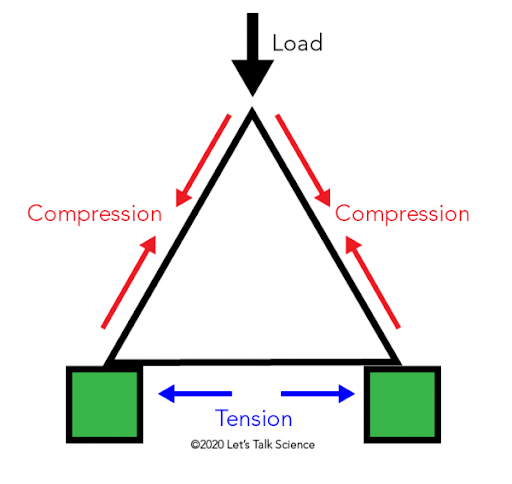
Image - Text Version
Shown is a colour diagram of a load on a triangle.
The black outline of an equilateral triangle takes up most of the image. Its base sits on two green squares.
A black arrow points down at the top point of the triangle. This is labelled "Load."
Each side of the triangle is labelled with two red arrows that run parallel to the edges. These point from the points of the triangle to the centre of each side. These arrows are labelled "Compression."
The base of the triangle is labelled with two blue arrows that run parallel to the edge. They point from the centre, out to the lower points. These arrows are labelled "Tension."
When a downward load is applied to the top of a square (or other flat-topped shape), the sides of the square experience compression and the base of the square experiences tension.
In this case, the downward force is not split between the vertical sides. All of the force is experienced by sides. Cubes and similar structures can be strong as long as their sides and bases are made of very strong materials.
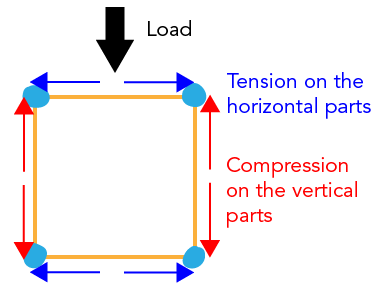
Image - Text Version
Shown is a colour diagram of a load on a cube.
An orange outline of a square takes up the left side of the illustration. Each corner of the square is marked with a pale blue circle.
A large black arrow points down at the centre of the top side. The is labelled "Load."
The top and bottom sides of the square are marked with blue arrows that run parallel to the outside edge. These point from the centres of each side, out to the corners. These arrows are labelled "Tension on the horizontal parts."
The right and left sides of the square are marked with red arrows that run parallel to the outside edge. These point from the centres of each side out to the corners. These arrows are labelled "Compression on the vertical parts."
Additional Resources
Reproducibles
- Structures Picture Glossary [Google doc] [Word doc] [PDF]
- It’s all in the shape slideshow [Google Slides] [pptx] [PDF]
- Shapes in Structures Observation Sheet reproducible [Google doc] [Word doc] [PDF]
- Making and Testing Shapes reproducible [Google doc] [Word doc] [PDF]
Books
Shaping Up Summer
In Shaping Up Summer, nature comes to life to help children grasp concepts of geometry, symmetry, and spatial sense.
Read-aloud version here.
ISBN 13 9781926973876
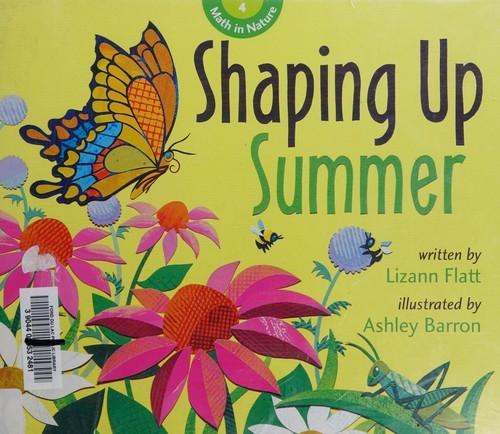
Dreaming up, a celebration of building
A collection of concrete poetry, illustrations, and photographs that shows how young children's constructions, created as they play, are reflected in notable works of architecture from around the world.
Read-aloud version here.
ISBN 13 9781600606519

How Things Are Made
By Oldrich Ruzicka
How was this made? Children have always wanted to know the answer to this question and this fun and eye-catching book provides answers.
ISBN 13 9781454920854
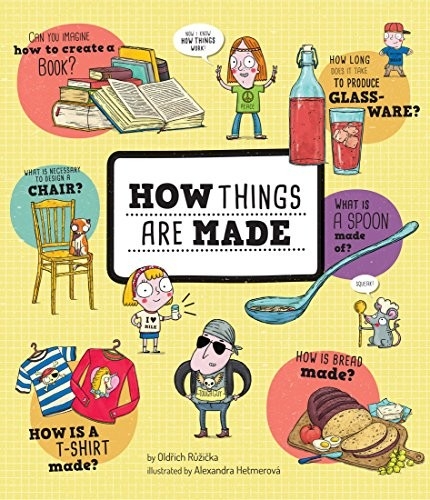
Videos
Building Strong Shapes Demo (2014)
This video (9:11 min.) from homeofficethink demonstrates how to build strong shapes using limited materials.
Bill Nye the Science Guy - S01E14 Structures (2018)
In this video (22:36 min.) Bill Nye explores structures.
Reproducibles and Media
Reproducibles
- Structures Picture Glossary [Google doc] [Word doc] [PDF]
- It’s all in the shape slideshow [Google Slides] [pptx] [PDF]
- Shapes in Structures Observation Sheet reproducible [Google doc] [Word doc] [PDF]
- Making and Testing Shapes reproducible [Google doc] [Word doc] [PDF]
Books
Shaping Up Summer
In Shaping Up Summer, nature comes to life to help children grasp concepts of geometry, symmetry, and spatial sense.
Read-aloud version here.
ISBN 13 9781926973876

Dreaming up, a celebration of building
A collection of concrete poetry, illustrations, and photographs that shows how young children's constructions, created as they play, are reflected in notable works of architecture from around the world.
Read-aloud version here.
ISBN 13 9781600606519

How Things Are Made
By Oldrich Ruzicka
How was this made? Children have always wanted to know the answer to this question and this fun and eye-catching book provides answers.
ISBN 13 9781454920854

Videos
Building Strong Shapes Demo (2014)
This video (9:11 min.) from homeofficethink demonstrates how to build strong shapes using limited materials.
Bill Nye the Science Guy - S01E14 Structures (2018)
In this video (22:36 min.) Bill Nye explores structures.
Science
- Provide students with pictures of well-known human-made structures in Canada and the world (e.g., the CN Tower, Eiffel Tower, the Leaning Tower of Pisa, Golden Gate Bridge). Students can then compare and contrast the structures (e.g., What shapes do they see? What do they notice about the foundation or base of each of them?) Those who are interested may wish to find out more about the structures and some of the engineering challenges of designing and building them.
- Students may prefer to explore structures constructed by animals (e.g., bird nests, beaver dams, bee hives, ant hills, etc.). Students can compare and contrast the shapes, materials and purpose of these animal-made structures to those made by humans.
- Students could explore ways to make shapes stronger and/or more stable (e.g., by adding struts, trusses and braces). Students could follow this Bridge Building activity.
Literacy
- Students could make mini-books with pages for different shapes. Using writing, labelled, drawings, photos, etc. they could describe where forces act on each shape and provide examples of objects where those shapes are found.
Mathematical Thinking
- Students could build and test other 3-dimensional figures not mentioned in this lesson (e.g., square-based pyramids, triangular prisms, hexagonal prisms, etc.).
- Measure and record the weight of the books used in testing using standard units.
Computational Thinking
- Students use a digital program to design shapes that they will then create using the materials provided.
Extensions
Science
- Provide students with pictures of well-known human-made structures in Canada and the world (e.g., the CN Tower, Eiffel Tower, the Leaning Tower of Pisa, Golden Gate Bridge). Students can then compare and contrast the structures (e.g., What shapes do they see? What do they notice about the foundation or base of each of them?) Those who are interested may wish to find out more about the structures and some of the engineering challenges of designing and building them.
- Students may prefer to explore structures constructed by animals (e.g., bird nests, beaver dams, bee hives, ant hills, etc.). Students can compare and contrast the shapes, materials and purpose of these animal-made structures to those made by humans.
- Students could explore ways to make shapes stronger and/or more stable (e.g., by adding struts, trusses and braces). Students could follow this Bridge Building activity.
Literacy
- Students could make mini-books with pages for different shapes. Using writing, labelled, drawings, photos, etc. they could describe where forces act on each shape and provide examples of objects where those shapes are found.
Mathematical Thinking
- Students could build and test other 3-dimensional figures not mentioned in this lesson (e.g., square-based pyramids, triangular prisms, hexagonal prisms, etc.).
- Measure and record the weight of the books used in testing using standard units.
Computational Thinking
- Students use a digital program to design shapes that they will then create using the materials provided.
What Makes Bridges So Strong? | Engineering for Kids (2015)
This video (3:45 min.) explains how bridges are built to be strong by using simple shapes!
Architectural Elements - Buffalo Architecture Foundation (PDF presentation)
This presentation shows several shapes that are used when strength is important, particularly in structures.
Balancing Act - Sick Science! #127 (2013)
This video from Sick Science! (1:22 min.) shows how you can balance a full-size textbook on a piece of paper.
Learn More
What Makes Bridges So Strong? | Engineering for Kids (2015)
This video (3:45 min.) explains how bridges are built to be strong by using simple shapes!
Architectural Elements - Buffalo Architecture Foundation (PDF presentation)
This presentation shows several shapes that are used when strength is important, particularly in structures.
Balancing Act - Sick Science! #127 (2013)
This video from Sick Science! (1:22 min.) shows how you can balance a full-size textbook on a piece of paper.
- Strickland, J. (June 2020). Grade 5: Forces Acting On Structures And Mechanisms. Ontario Council For Technology Education.
References
- Strickland, J. (June 2020). Grade 5: Forces Acting On Structures And Mechanisms. Ontario Council For Technology Education.
Reproducibles
- Structures Picture Glossary [Google doc] [Word doc] [PDF]
- It’s all in the shape slideshow [Google Slides] [pptx] [PDF]
- Shapes in Structures Observation Sheet reproducible [Google doc] [Word doc] [PDF]
- Making and Testing Shapes reproducible [Google doc] [Word doc] [PDF]
Books
Shaping Up Summer
In Shaping Up Summer, nature comes to life to help children grasp concepts of geometry, symmetry, and spatial sense.
Read-aloud version here.
ISBN 13 9781926973876

Dreaming up, a celebration of building
A collection of concrete poetry, illustrations, and photographs that shows how young children's constructions, created as they play, are reflected in notable works of architecture from around the world.
Read-aloud version here.
ISBN 13 9781600606519

How Things Are Made
By Oldrich Ruzicka
How was this made? Children have always wanted to know the answer to this question and this fun and eye-catching book provides answers.
ISBN 13 9781454920854

Videos
Building Strong Shapes Demo (2014)
This video (9:11 min.) from homeofficethink demonstrates how to build strong shapes using limited materials.
Bill Nye the Science Guy - S01E14 Structures (2018)
In this video (22:36 min.) Bill Nye explores structures.
Reproducibles and Media
Reproducibles
- Structures Picture Glossary [Google doc] [Word doc] [PDF]
- It’s all in the shape slideshow [Google Slides] [pptx] [PDF]
- Shapes in Structures Observation Sheet reproducible [Google doc] [Word doc] [PDF]
- Making and Testing Shapes reproducible [Google doc] [Word doc] [PDF]
Books
Shaping Up Summer
In Shaping Up Summer, nature comes to life to help children grasp concepts of geometry, symmetry, and spatial sense.
Read-aloud version here.
ISBN 13 9781926973876

Dreaming up, a celebration of building
A collection of concrete poetry, illustrations, and photographs that shows how young children's constructions, created as they play, are reflected in notable works of architecture from around the world.
Read-aloud version here.
ISBN 13 9781600606519

How Things Are Made
By Oldrich Ruzicka
How was this made? Children have always wanted to know the answer to this question and this fun and eye-catching book provides answers.
ISBN 13 9781454920854

Videos
Building Strong Shapes Demo (2014)
This video (9:11 min.) from homeofficethink demonstrates how to build strong shapes using limited materials.
Bill Nye the Science Guy - S01E14 Structures (2018)
In this video (22:36 min.) Bill Nye explores structures.
Science
- Provide students with pictures of well-known human-made structures in Canada and the world (e.g., the CN Tower, Eiffel Tower, the Leaning Tower of Pisa, Golden Gate Bridge). Students can then compare and contrast the structures (e.g., What shapes do they see? What do they notice about the foundation or base of each of them?) Those who are interested may wish to find out more about the structures and some of the engineering challenges of designing and building them.
- Students may prefer to explore structures constructed by animals (e.g., bird nests, beaver dams, bee hives, ant hills, etc.). Students can compare and contrast the shapes, materials and purpose of these animal-made structures to those made by humans.
- Students could explore ways to make shapes stronger and/or more stable (e.g., by adding struts, trusses and braces). Students could follow this Bridge Building activity.
Literacy
- Students could make mini-books with pages for different shapes. Using writing, labelled, drawings, photos, etc. they could describe where forces act on each shape and provide examples of objects where those shapes are found.
Mathematical Thinking
- Students could build and test other 3-dimensional figures not mentioned in this lesson (e.g., square-based pyramids, triangular prisms, hexagonal prisms, etc.).
- Measure and record the weight of the books used in testing using standard units.
Computational Thinking
- Students use a digital program to design shapes that they will then create using the materials provided.
Extensions
Science
- Provide students with pictures of well-known human-made structures in Canada and the world (e.g., the CN Tower, Eiffel Tower, the Leaning Tower of Pisa, Golden Gate Bridge). Students can then compare and contrast the structures (e.g., What shapes do they see? What do they notice about the foundation or base of each of them?) Those who are interested may wish to find out more about the structures and some of the engineering challenges of designing and building them.
- Students may prefer to explore structures constructed by animals (e.g., bird nests, beaver dams, bee hives, ant hills, etc.). Students can compare and contrast the shapes, materials and purpose of these animal-made structures to those made by humans.
- Students could explore ways to make shapes stronger and/or more stable (e.g., by adding struts, trusses and braces). Students could follow this Bridge Building activity.
Literacy
- Students could make mini-books with pages for different shapes. Using writing, labelled, drawings, photos, etc. they could describe where forces act on each shape and provide examples of objects where those shapes are found.
Mathematical Thinking
- Students could build and test other 3-dimensional figures not mentioned in this lesson (e.g., square-based pyramids, triangular prisms, hexagonal prisms, etc.).
- Measure and record the weight of the books used in testing using standard units.
Computational Thinking
- Students use a digital program to design shapes that they will then create using the materials provided.
What Makes Bridges So Strong? | Engineering for Kids (2015)
This video (3:45 min.) explains how bridges are built to be strong by using simple shapes!
Architectural Elements - Buffalo Architecture Foundation (PDF presentation)
This presentation shows several shapes that are used when strength is important, particularly in structures.
Balancing Act - Sick Science! #127 (2013)
This video from Sick Science! (1:22 min.) shows how you can balance a full-size textbook on a piece of paper.
Learn More
What Makes Bridges So Strong? | Engineering for Kids (2015)
This video (3:45 min.) explains how bridges are built to be strong by using simple shapes!
Architectural Elements - Buffalo Architecture Foundation (PDF presentation)
This presentation shows several shapes that are used when strength is important, particularly in structures.
Balancing Act - Sick Science! #127 (2013)
This video from Sick Science! (1:22 min.) shows how you can balance a full-size textbook on a piece of paper.
- Strickland, J. (June 2020). Grade 5: Forces Acting On Structures And Mechanisms. Ontario Council For Technology Education.
References
- Strickland, J. (June 2020). Grade 5: Forces Acting On Structures And Mechanisms. Ontario Council For Technology Education.